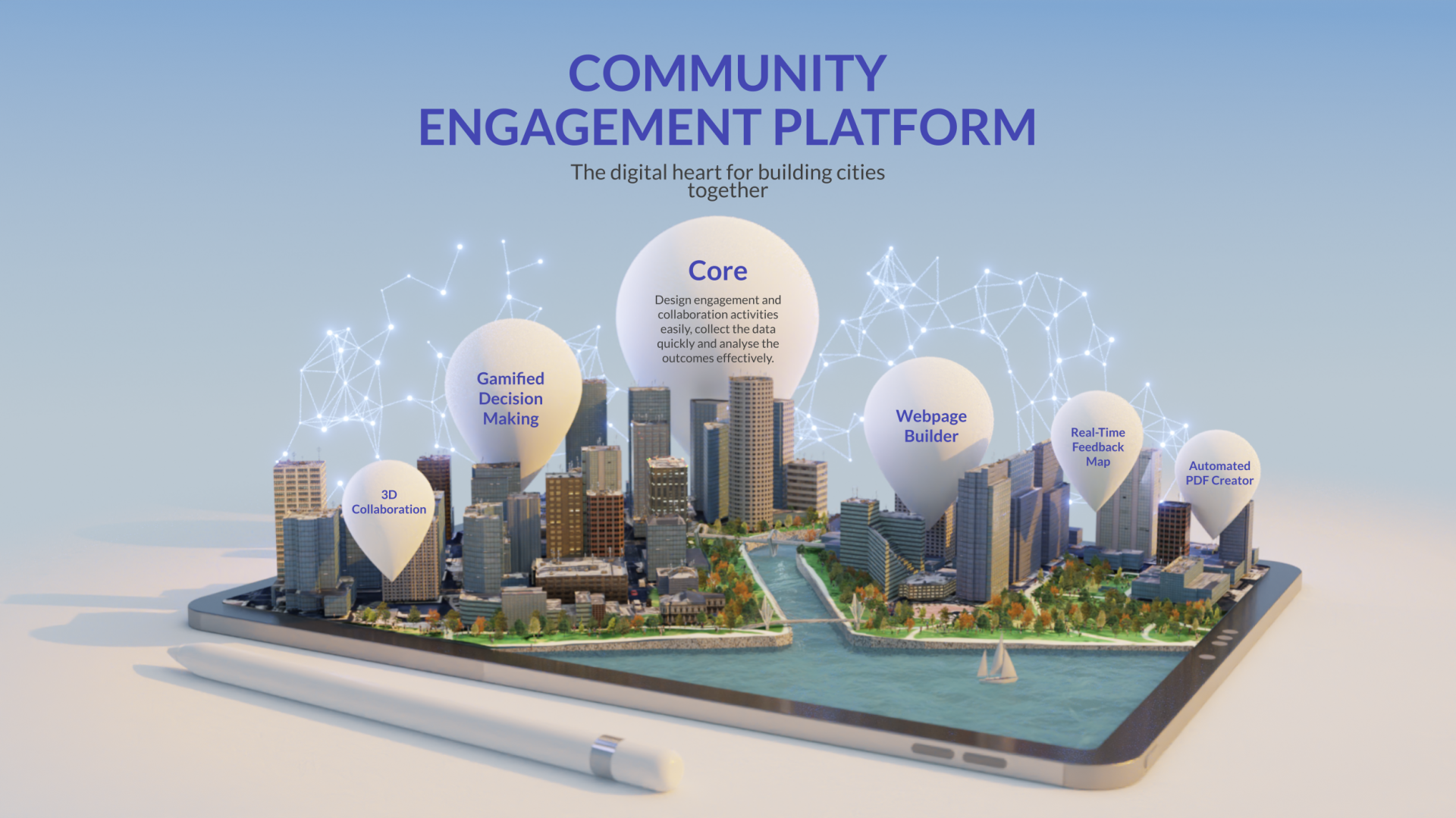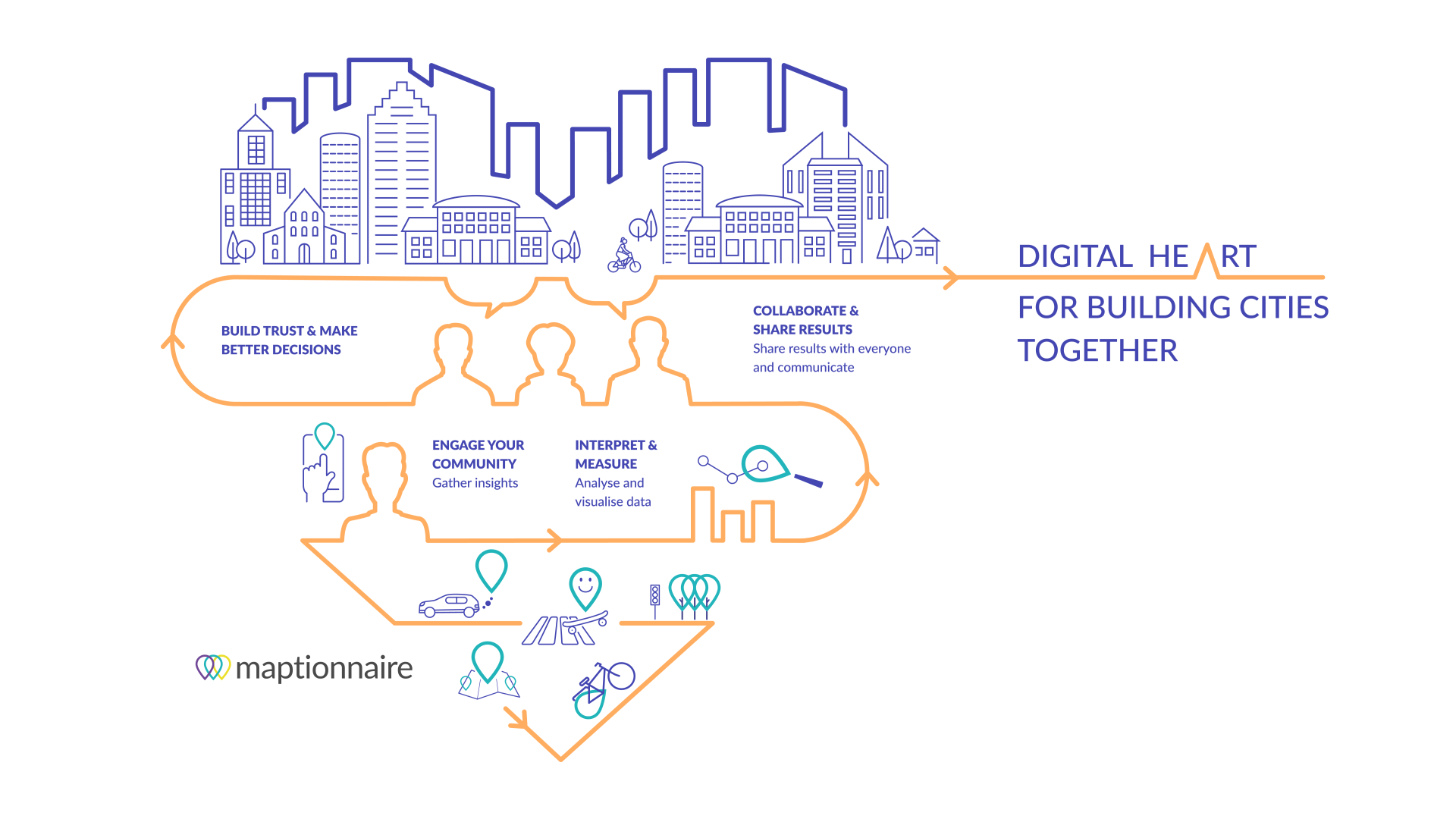Maptionnaire
Basic information
Project Title
Full project title
Category
Project Description
Maptionnaire is a solution for listening to the community and its members. With our service, cities, consultancies and research organizations can achieve a broader and more inclusive reach (compared to “traditional”, face-to-face engagement alone). It also allows for the typically silent minority in e.g. city planning processes to voice out their views and opinions about the plans. By using Maptionnaire, the entire engagement process can be more transparent and promote good governance.
Geographical Scope
Project Region
Urban or rural issues
Physical or other transformations
EU Programme or fund
Which funds
Description of the project
Summary
Digitalization is driving organizational change, but cities are in danger of fossilizing their old processes with past inefficiencies when they merely move their current models of delivery online. What is actually needed is not a digital redesign of old processes but a re-evaluation of everything the city is doing under a single platform.
The renewed Maptionnaire platform is based on redefining citizen engagement as an ecosystem of data linked primarily to locations, not to specific sectors and projects. It allows a systematic and comprehensive collection of feedback that is not limited by time, space, or sector. Furthermore, it provides 20 times more feedback from a larger and more representative sample of inhabitants that can be analyzed and reported in a consistent and efficient manner also spatially. Maptionnaire produces over 60% improvement in time used for analyzing the feedback from citizens.
The combined effect of Maptionnaire Community Engagement Platform – which positively affects the efficiency and quality, creates synergies across sectors, and increases citizens’ satisfaction – is dramatic. The service is comprehensive, affordable and it provides a step-change in managing community engagement in an easy manner, unmatched by any alternative available today. In the presentation, we will share the insights of the most latest Maptionnaire projects and concentrate to explore the benefits and challenges in using Maptionnaire more in 3D environments.
Key objectives for sustainability
We strive at purchasing services from companies that recognize their responsibility towards the environment as well as people. Our daily / business-as-usual principles at the office include paperless office, recycling, energy-efficient work stations, supporting the use of public transport for all travel, reducing international travel. We promote openness and equal opportunities for our employees. We also offer possibilities for occupational development by offering training to everyone. Mapita adheres to ILO’s (International Labor Organization) principles and the UN’s Convention on the Rights of the Child.
Key objectives for aesthetics and quality
Maptionnaire is visually appealing - the colors, background pictures, and maps can be modified according to cities' wishes to attract more people to participate. We use clear fonts and colors to make the contents visually accessible for the users. The Maptionnaire service also fulfills all the requirements for accessibility (Web Content Accessibility Guidelines (WCAG)).
The Maptionnaire service is usable on mobile devices.
Key objectives for inclusion
The basic principle of the Maptionnaire service is to provide a platform especially for listening to the community and its members. With our service, cities, consultancies, and research organizations can achieve a broader and more inclusive reach (compared to “traditional”, face-to-face engagement alone). It also allows for the typically silent minority in e.g. city planning processes to voice out their views and opinions about the plans. By using Maptionnaire, the entire engagement process can be more transparent and promote good governance as it’s also possible to communicate clearly to the community via the platform. Maptionnaire’s use cases are also varied: it can be used to solve challenges in urban planning, that may also include environmental and social issues (e.g. where to provide affordable housing).
Results in relation to category
The Maptionnaire Community Engagement Platform is unique in its ability to remove barriers of time, space, and sector allowing all citizens to participate on the go. The importance for the cities is the combined cost savings and time gains in reaching more people and acquiring data with better quality in comparison to the current state of the art.
The benefits that Maptionnaire Community Engagement Platform brings include:
- Broader reach, inclusive for otherwise silent groups.
- Higher resident satisfaction.
- Increased transparency and good governance
- Cost savings between 30%-90% delivered per participant depending on participatory tool; 64% service time improvement in the analysis of citizens’ feedback and reporting while acquiring 400% more responses
While participatory mapping and community engagement are now widely accepted methods to enhance the democratic aims of community and urban development, challenges remain. Maptionnaire facilitates the adoption of online methods for inclusive planning, value diversity, secure accessibility, and affordability while streamlining the planning process.
By implementing effective tools, planners will also learn how to make community engagement more strategic with the help of quality datasets produced by the people. Co-creation will increase its importance in solving societal challenges – climate change, circularity, zero pollution and biodiversity. Maptionnaire's approach demonstrates how digital transformation can help approach these complex problems. To promote a sustainable future, we need capability and tools that help us to co-create better places together.
How Citizens benefit
As a spin-off company from Aalto University, we want to be accessible globally. We respect the wishes and ideas of our customers when developing the software.
Our customer projects have mainly involved the development of the urban and communal structure towards a more sustainable one and the organizing of more efficient and transparent engagement processes. With the help of Maptionnaire, people’s experiences have been gathered to inform and support decision-making that might include areas such as redevelopment, zoning, city planning, nature’s diversity, and nature preserves.
Physical or other transformations
Innovative character
The platform has been used by researchers, planners and activists in different application areas, e.g. urban planning, transportation planning, landscape values. The value of the method is that it is usable in different planning phases: from the initiation, to formulation, decision-making, and evaluation, from collecting ideas to asking opinions on plans.
Learning transferred to other parties
Given its nature as a SaaS solution, Maptionnaire features extensive transferability of user-generated data and insights. This transferability can be observed in the diversity of the customer cases highlighted on Maptionnaire's website, Maptionnaire's Community Hub, and the development of the service itself.
When a city implements a project using Maptionnaire, the collected data is usable by multiple departments. The benefits of leveraging resident-generated data are visible to other cities, where a successful implementation be replicated. Successful implementations are also showcased by Maptionnaire, providing other potential parties a sneak peek at the process and its results. An example of multidepartmental benefit includes how the zoning and the urban engineering departments at the City of Vaasa in Finland have universally benefited from the service, even supporting them in developing the best practices for community engagement (for more information on Case Vaasa: https://maptionnaire.com/best-participation-practices/zoning-urban-planning-city-of-vaasa-finland).
Effective community engagement is also an essential tool for the consultancy sector. In the Netherlands, a consultancy implemented Maptionnaire's service to help create inspiring public places for young people. The objective of the project was to improve their opportunities and well-being. Collecting user-generated data from the residents from various age groups has enabled them to positively impact the development of the upcoming generations (for more information on Case OBBEngineers: https://maptionnaire.com/best-participation-practices/design-playgrounds-obbengineers).
Maptionnaire develops with the projects its customers implement. The accumulated information regarding the processes, methods and best practices in community engagement is cataloged in Maptionnaire's Community Hub, freely accessible to all interested parties (access here: https://support.maptionnaire.com/hc/en-us).


